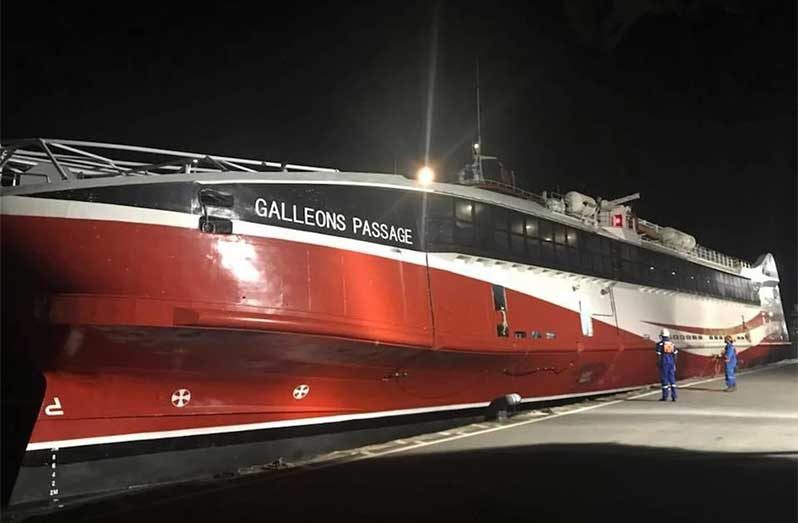…as CARICOM pushes regional ferry plan
A SINGLE ticket for sea travel between Guyana, Trinidad and Tobago and Barbados, with stops to other Caribbean islands, could soon cost less than US$100.
This comes as the Caribbean Community (CARICOM) intensifies efforts to revolutionise regional transportation and deepen economic integration across member states.
Barbados’ Minister of Foreign Affairs and Foreign Trade, Kerrie Symmonds, announced the initiative during a recent press conference following the recent CARICOM Heads of Government Meeting in Jamaica.
The plan, he said, is not only to move goods more efficiently but also to allow affordable and practical movement of people throughout the region.
“The ambition is to have those costs per person well beneath US$100—making access between the islands far more competitive,” Symmonds declared, as he outlined a vision for seamless regional travel similar to that found in Europe.
While a vessel has already been identified for cargo transport between Guyana and Barbados, the initiative has grown to include the development of a passenger ferry system with possible stops in St. Vincent and the Grenadines, Dominica, and other CARICOM states.
Symmonds emphasised that the aim is not simply logistical—it is transformational.

“The intention is to have connectivity across the island chain,” the foreign minister explained. “For example, those products which may be brought from Guyana to Barbados may now then be carried to St Vincent and the Grenadines and Dominica.”
Symmonds also painted a picture of an integrated future where regional entrepreneurs can easily move goods and services. “The businessman in Dominica who wishes to obtain some supplies from a hardware store in Barbados may wish to drive his van onto a ferry, be able to bring that van to Barbados, collect the things he wants, drive back onto that ferry and go back home,” he said.
According to Symmonds, this is a model that has already proven effective in Europe and could similarly serve as a powerful tool to advance the Caribbean Single Market and Economy (CSME). “They [Europe] have succeeded in deepening their integration movement. We in CARICOM have now come to the point of deepening ours in a similar capacity,” he added.
The minister confirmed that “RoPax” vessels—designed for both roll-on/roll-off cargo and passenger service—have been identified. Similar vessels are currently used in ferry operations between Trinidad and Tobago.
“This is a process that is going to require substantial work over the next few weeks,” he noted. As part of the effort, Symmonds and Jamaica’s Minister of Foreign Affairs, Kamina Johnson Smith, have been appointed as lead ministers to oversee implementation.
Symmonds will focus on the southern Caribbean, while Johnson Smith will lead efforts in the northern region.
Key to the plan’s success will be the support of the private sector—and early signs are promising. “Discussion with the CARICOM Private Sector Organization (CPSO) indicates that they are onboard,” Symmonds confirmed. “The discussion now is how we can drive the cost down.”
However, the initiative is not without challenges. Several legal and infrastructural obstacles must be addressed before passengers and vehicles can freely move between states.
“There has to be enhanced port facilities or, as we know it, free movement at ports of entry,” Symmonds stated.
The Barbadian minister identified four key priority areas for harmonisation to support the successful rollout of the regional ferry initiative.
These include the mutual recognition of vehicle registration among CARICOM member states and the acceptance of driver permits and licences across participating countries.
Additionally, he stressed the need to streamline vehicle insurance policies, so they are valid across borders. This, according to him, is a potential area of some challenge because every jurisdiction has its own insurance policies.
“The policies are jurisdiction-specific. And in some cases, the reinsurers are not the same either. So, the reinsurers for many companies in one country may not be the same as others. And therefore, there is a level of harmonisation that has to be done not only at the regional level, but also with global and international considerations…,” he pointed out.
Upgrading port infrastructure to efficiently and safely accommodate ferry traffic was also highlighted as a critical requirement.
Symmonds explained: “With regard to roll-on/roll-off vehicles, some ports are going to have to go through a period of upgrade in order for them to build up the capacity. In order for them to do this—and it is a matter of priority—it will be expected that member states will be paying detailed attention to that.”
He noted that another critical hurdle to be addressed is the elimination of non-tariff barriers, which continue to obstruct trade and the free movement of goods within CARICOM.
“These are some things that we now have to do,” he said, noting that solutions are already under consideration and that technical teams will work alongside national authorities to address the gaps.
He expressed optimism that once these issues are resolved in the coming months, the long-envisioned regional ferry system will finally come to life.
The sea bridge between Guyana, Trinidad, Barbados and other CARICOM states will not only reduce the financial burden on travellers and traders but also enhance food security, strengthen tourism links, and bring CARICOM’s long-touted single market vision closer to reality.
CARI Cargo Inc., the company responsible for regional ferry service among Guyana, Barbados, and Trinidad and Tobago, was incorporated in Georgetown, Guyana last year.
Then, it was reported that Trinidad and Tobago’s Galleons Passage will commence operations between Guyana and Trinidad initially, with plans to extend services to Barbados.
The vessel boasts a capacity for 400 passengers and 60 cars, along with on-board amenities including a cafeteria, bar, and a very important person (VIP) lounge.
President Dr. Irfaan Ali has already announced that, on Guyana’s end, the vessel will operate out of Parika, located in Region Three (Essequibo Islands–West Demerara).





.jpg)








